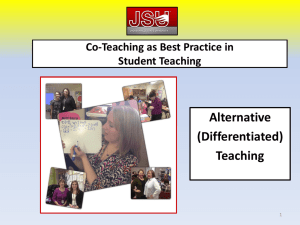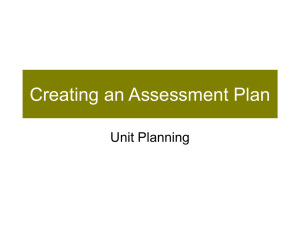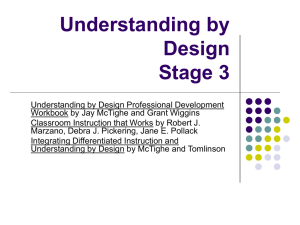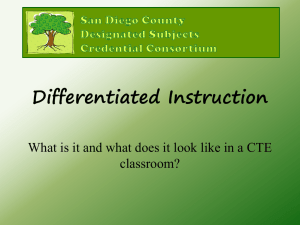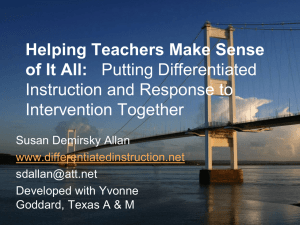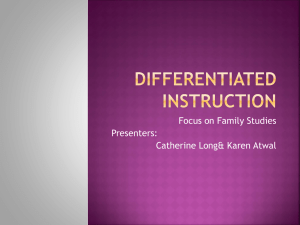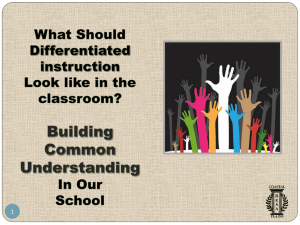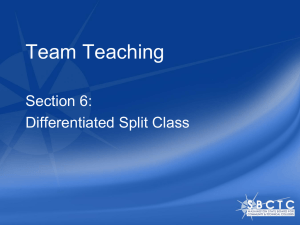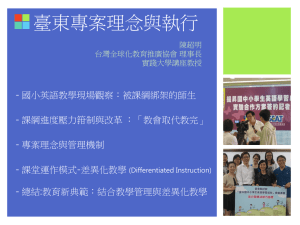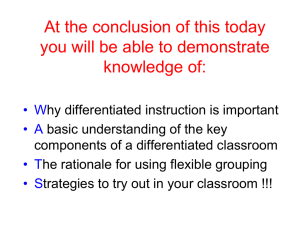PowerPoint
advertisement
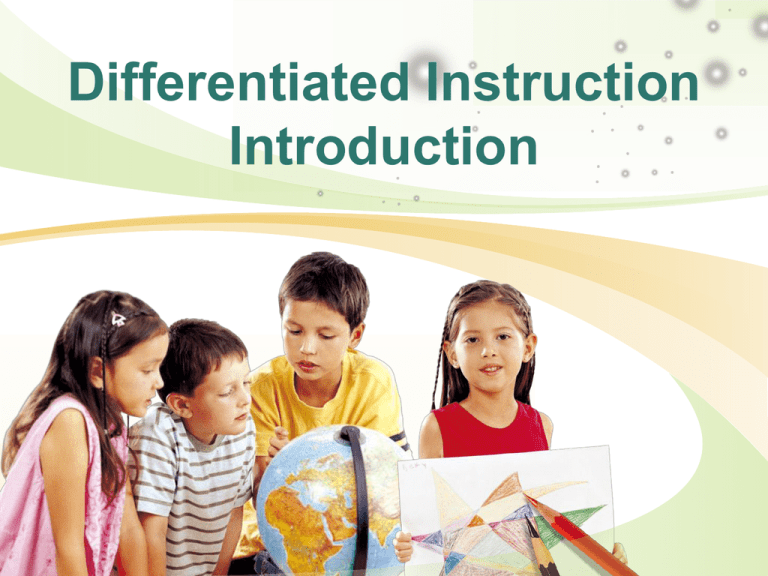
Differentiated Instruction Introduction “Learning has nothing to do with what a teacher covers. Learning has to do with what the students accomplish.” Harry Wong Outcomes for Participants Participants will be able to: • Define Differentiated Instruction • Understand the Importance of DI • Align DI with PLC Learning Questions Professional Learning Communities Standards Teaching Para-Educator Administration Differentiated Instruction Teaching Standards: •Uses strategies to deliver instruction that meets the multiple learning needs of students •Selects strategies to engage all students in learning. •Uses a variety of methods to monitor student learning. •Demonstrates competence in classroom management PLC Big Idea #1 Focus on Learning We accept high levels of learning for all students as the fundamental purpose of our school and therefore are willing to examine all practices in light of their impact on learning. Excellence for All To have a mission of learning for all You must believe all students can learn at high levels You must take responsibility to ensure that all students learn. 4 Learning Questions What do we wantStudent eachLearning students to Expectations know or be able to do? How will we know they have learned? Formative Assessment What evidence do we have of the learning? Differentiation/Enrichment How do we respond when students don’t learn or struggle?Response to Intervention Intervention How do we respond toPyramid thoseof who Learning Supports 4have Learning Questions already learned? Student Questions What do I need to know? Where am I now? How do I get there? What happens if I struggle or fail? What do we want students to know and be able to do? Standards/Benchmarks (Learning Outcomes) Classroom SMART goals & SMART targets How will we know if they can do it? Formative assessments/cycle Multiple data sets Protocol for data analysis (ASW) How will we respond when they can’t? Core Instruction Differentiated Instruction Enrichment Pyramid Response to Intervention Learning Supports Manage ment Culture + Instruction & Assessment Student Engagement Learning Focus Learning Environment = Differentiat ed Classroom Differentiated Classroom Management Student Engagement Differentiated Classroom Instruction & Assessment Culture Definition of Differentiated Instruction Differentiated Instruction is an approach that empowers both teachers and Carefully crafted instruction students to maximize learning for all by responds to individual profiles, Throughmultiple DI, teachers take providing pathways forinto students interests and they readiness account who teach, what of to take in information, makeby sense modifying content, process and they teach, wherewhat they teach ideas, and express they have products. learned. and how they teach. Definition of Differentiated Instruction Differentiated Instruction (DI) is an approach that empowers both teachers and students to maximize learning for all by providing multiple pathways for students to take in information, make sense of ideas, and express what they have learned. Carefully crafted instruction responds to individual profiles, interests and readiness by modifying content, process and products. Through DI, teachers take into account who they teach, what they teach, where they teach and how they teach. The basic premise of DI is that students are different. Teachers of effective heterogeneous classrooms recognize the similarities and differences in students and proactively plan for these differences. Cassandra Erkens, 2008 Anam Cara Consulting, Inc http://www.anamcaraconsulting.com Differentiated Instruction Continuum Not Differentiated “One-Size-Fits-All” Highly Differentiated Assessment Learning Profile Tiered Activities Curriculum Compacting Learning Contracts Independent Study Flexible Grouping Anchor Activities Learning Centers/Stations Problem-Based Learning Project-Based Learning Differentiated Instruction Continuum Not Differentiated Highly Differentiated “One-Size-Fits-All” EVERYONE IS ON THE JOURNEY!! Assessment Learning Profile Tiered Activities Curriculum Compacting Learning Contracts Independent Study Flexible Grouping Anchor Activities Learning Centers/Stations Problem-Based Learning Project-Based Learning Let’s visit a few classrooms … Case Study Vicki Barrett’s fifth-grade math class… Scott Marsh’s fifth graders are also… Read and Discuss: How is each differentiating instruction? 14 Definition of Differentiated Instruction Differentiated Instruction (DI) is an approach that empowers both teachers and students to maximize learning for all by providing multiple pathways for students to take in information, make sense of ideas, and express what they have learned. Carefully crafted instruction responds to individual profiles, interests and readiness by modifying content, process and products. Through DI, teachers take into account who they teach, what they teach, where they teach and how they teach.
